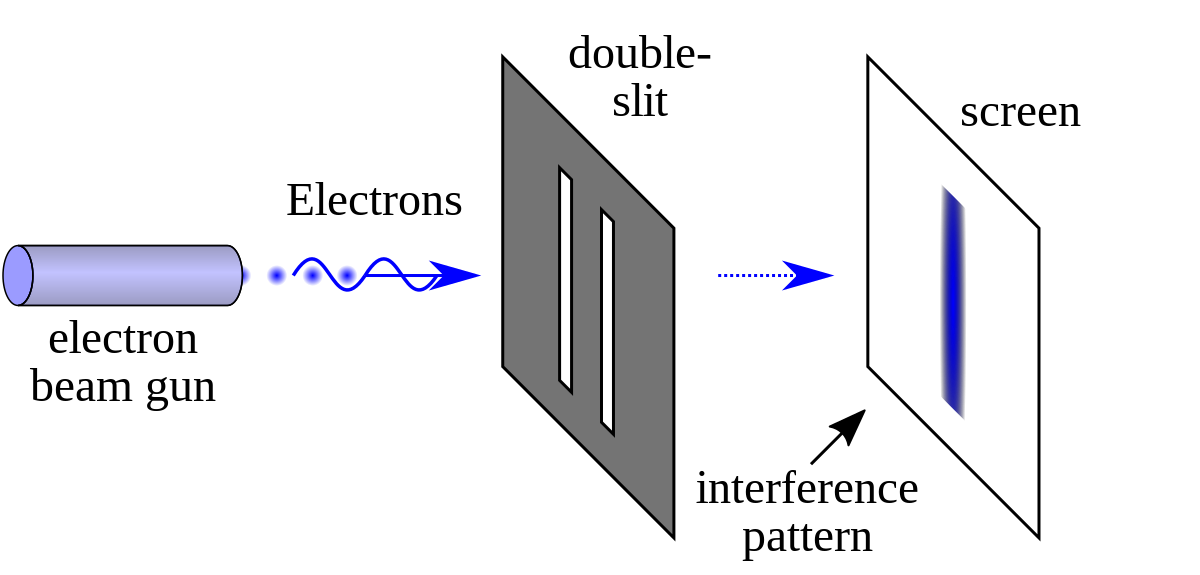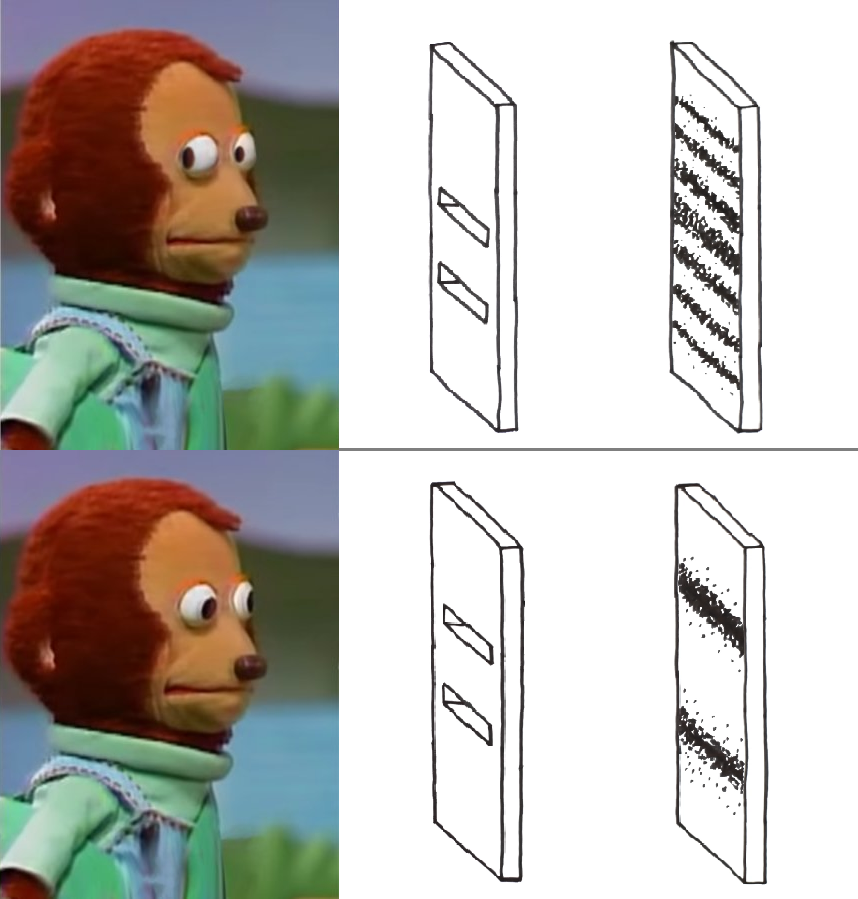A lot of people have been exposed to Young's famous Double Slit Experiment, which introduces students to the wave/particle duality of light. But this experiment takes us fully into the strange realm of quantum mechanics, too.

I've included a sequence of videos below that gradually increase in mindfuckery, but should be fun for curious gaffers. Apologies for any errors in my summaries and explanations.
In the experiment, a photon or electron is shot toward two slits and there is a sheet on the other end that reacts to where it ends up. An interference pattern occurs when an initial wave sent to the two slits splits into two waves and these waves collide with each other on the other side, per the figure above. We can tell when something is behaving as a wave if it produces that interference pattern on the sheet at the other end. If it's behaving as a particle, the interference pattern won't form and we'll just see two lines on the sheet.
The Double Slit experiment works for some atoms as well (a little differently). Shoot a stream of atoms at the two slits, and they'll behave like waves, forming an interference pattern where they end up on the other side. Drop the frequency down to one atom at a time and you'll detect one atom at a time on the other end, behaving like a particle, but eventually, by continuing to shoot one atom at a time toward the two slits, a wave-like interference pattern will form on the other side, even though each atom is not being split between the two slits and multiple atoms are not interacting with each other en route.
Well, let's try observing which slit each atom passes through to get more information. When you do measure which slit each atom passes through via a detector, the interference pattern on the far end disappears, instead showing a straightforward two-slit pattern with the atoms returning to behaving like particles, or bullets passing through two holes in a steel plate. Watch the first video for a clearer picture:
The second video gets more into the quantum mechanics involved in our attempts to explain what is going on in the double-slit experiment. We could think of the trajectory from the starting point to the endpoint as a superposition of all the possible outcomes, a probability wave function moving through both slits that collapses into a particle when directly measured/observed.
The third video, on the Quantum Eraser, is where it gets really mental. Physicists devised a method to split a photon into two identical half-energy photons after passing through the two slits, sending one of the photons in the new pair to the interference screen as before, but the other photon to a detector that tells us which of the two slits the pre-split photon passed through, as a method of indirect observation of the first photon.
Even though they're separate photons at that point and we're not observing the one sent to the interference screen -- observing it changes its behavior from a wave to a particle -- if we observe the OTHER photon in the pair, the interference pattern produced by the photon sent to the screen disappears as if we observed it and not its buddy, an example of quantum entanglement between the photons.

But there's more: the experiment was designed so that the observation of the second photon from the pair is farther away than the distance between the first photon traverses to the screen, and therefore takes place AFTER the first photon has ALREADY HIT the interference screen. If the first photon or its entangled buddy aren't observed en route, it should behave as a wave and produce an interference pattern on the screen. Yet the observation of the second photon that tells us which of the two slits it passed through takes place after the first photon has already hit the screen...and that observation reverts the first photon's outcome to particle behavior (ignoring causality, since it has already hit the screen...) and prevents the interference pattern from forming.

Not done yet. Now for the Quantum Eraser, where the experiment above is done, but some of the second split-photons don't go to the A/B slit detector, and instead continue along and pass through a beam splitter in such a way where we can no longer know which of the two slits the photon originally passed through when it's measured by another set of detectors (i.e. the information about which slit it traversed is destroyed, called the which-path information). And in that case, the interference pattern from the first photon re-appears.
And, let's not forget that the first photon had already reached its destination when these various events with the second photon transpire, so this is changing the past.
Thoughts?

I've included a sequence of videos below that gradually increase in mindfuckery, but should be fun for curious gaffers. Apologies for any errors in my summaries and explanations.
In the experiment, a photon or electron is shot toward two slits and there is a sheet on the other end that reacts to where it ends up. An interference pattern occurs when an initial wave sent to the two slits splits into two waves and these waves collide with each other on the other side, per the figure above. We can tell when something is behaving as a wave if it produces that interference pattern on the sheet at the other end. If it's behaving as a particle, the interference pattern won't form and we'll just see two lines on the sheet.
The Double Slit experiment works for some atoms as well (a little differently). Shoot a stream of atoms at the two slits, and they'll behave like waves, forming an interference pattern where they end up on the other side. Drop the frequency down to one atom at a time and you'll detect one atom at a time on the other end, behaving like a particle, but eventually, by continuing to shoot one atom at a time toward the two slits, a wave-like interference pattern will form on the other side, even though each atom is not being split between the two slits and multiple atoms are not interacting with each other en route.
Well, let's try observing which slit each atom passes through to get more information. When you do measure which slit each atom passes through via a detector, the interference pattern on the far end disappears, instead showing a straightforward two-slit pattern with the atoms returning to behaving like particles, or bullets passing through two holes in a steel plate. Watch the first video for a clearer picture:
The second video gets more into the quantum mechanics involved in our attempts to explain what is going on in the double-slit experiment. We could think of the trajectory from the starting point to the endpoint as a superposition of all the possible outcomes, a probability wave function moving through both slits that collapses into a particle when directly measured/observed.
The third video, on the Quantum Eraser, is where it gets really mental. Physicists devised a method to split a photon into two identical half-energy photons after passing through the two slits, sending one of the photons in the new pair to the interference screen as before, but the other photon to a detector that tells us which of the two slits the pre-split photon passed through, as a method of indirect observation of the first photon.
Even though they're separate photons at that point and we're not observing the one sent to the interference screen -- observing it changes its behavior from a wave to a particle -- if we observe the OTHER photon in the pair, the interference pattern produced by the photon sent to the screen disappears as if we observed it and not its buddy, an example of quantum entanglement between the photons.

But there's more: the experiment was designed so that the observation of the second photon from the pair is farther away than the distance between the first photon traverses to the screen, and therefore takes place AFTER the first photon has ALREADY HIT the interference screen. If the first photon or its entangled buddy aren't observed en route, it should behave as a wave and produce an interference pattern on the screen. Yet the observation of the second photon that tells us which of the two slits it passed through takes place after the first photon has already hit the screen...and that observation reverts the first photon's outcome to particle behavior (ignoring causality, since it has already hit the screen...) and prevents the interference pattern from forming.

Not done yet. Now for the Quantum Eraser, where the experiment above is done, but some of the second split-photons don't go to the A/B slit detector, and instead continue along and pass through a beam splitter in such a way where we can no longer know which of the two slits the photon originally passed through when it's measured by another set of detectors (i.e. the information about which slit it traversed is destroyed, called the which-path information). And in that case, the interference pattern from the first photon re-appears.
And, let's not forget that the first photon had already reached its destination when these various events with the second photon transpire, so this is changing the past.
Thoughts?








